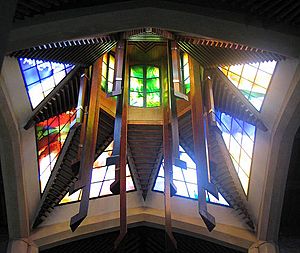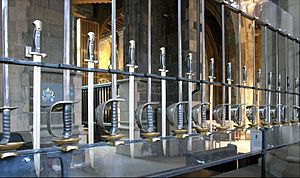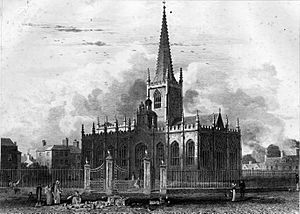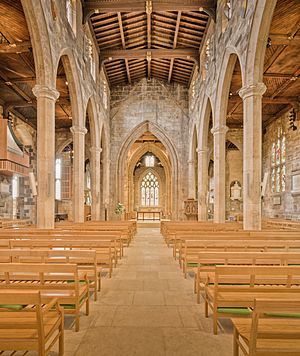Sheffield Cathedral facts for kids
Quick facts for kids Sheffield Cathedral |
|
|---|---|
| Cathedral Church of St Peter and St Paul | |
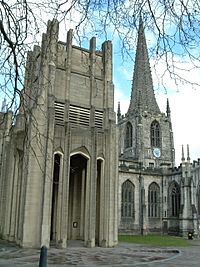 |
|
| Lua error in Module:Location_map at line 420: attempt to index field 'wikibase' (a nil value). | |
| OS grid reference | SK 35387 87511 |
| Location | Sheffield, South Yorkshire |
| Country | England |
| Denomination | Church of England |
| Website | sheffieldcathedral.org |
| Architecture | |
| Architect(s) | Flockton & Gibbs (1870s) Charles Nicholson (1936–48) George Pace and Ansell & Bailey (1960–66) |
| Style | Gothic, Modernist |
| Years built | c. 1200–1966 |
| Specifications | |
| Height | 49 metres (161 ft) to the tip of the spire |
| Administration | |
| Diocese | Sheffield (since 1914) |
| Province | York |
The Cathedral Church of St Peter and St Paul, Sheffield, often called Sheffield Cathedral, is a main church for the Church of England in Sheffield, England. It started as a regular local church. In 1914, it became a cathedral when the Diocese of Sheffield was created. Sheffield Cathedral is one of only five Grade I listed buildings in the city. This means it's a very important historic building.
The cathedral is in the city centre on Church Street. It's near the top of Fargate. The oldest parts of the building date back to around 1200. The newest parts were finished in 1966. This mix makes it a unique building with both old and modern styles. The Cathedral tram stop is right outside. It opened in 1994 and is used by all four lines of the Sheffield Supertram network. The cathedral was also updated inside and out between 2013 and 2014.
Sheffield Cathedral had a fire on May 14, 2020. This fire damaged a part of the cathedral used by a charity that helps people without homes. There was also a fire in the belltower in 1979.
Contents
History of the Cathedral
The place where the cathedral stands has been used for Christian worship for a very long time. A piece of a 9th-century cross, called the Sheffield Cross, was likely here before. It is now kept at the British Museum. Sheffield's first local church was probably built here in the 12th century. It was built by William de Lovetot. This church was burned down in 1266 during a war against King Henry III.
A new church was finished in 1280. However, most of this church was taken down and rebuilt around 1430. The new church had a cruciform (cross-shaped) floor plan. The Shrewsbury Chapel was added in the 1500s. A small chapel, now called the Chapel of Saint Katherine, was added in 1777. The north and south walls of the main part of the church (the nave) were rebuilt from 1790 to 1793. A big restoration by Flockton & Gibbs finished in 1880. This work added new north and south transepts (the arms of the cross shape). The church was first named after Saint Peter. Later, it was called Holy Trinity. Now, it is named after both Saint Peter and Saint Paul.
The area around the church was divided into smaller parishes in 1848. The church is still the main church for the smaller Parish of Sheffield. But in 1914, it also became the cathedral for the new Diocese of Sheffield. Plans were made by Charles Nicholson to make the church bigger. But because of World War II, these plans were made much smaller. The changes that were made gave the church an unusual shape.
Fires at the Cathedral
Sheffield Cathedral has experienced two notable fires in its recent history.
1979 Fire Incident
In the early morning of July 17, 1979, a large fire started in the belltower of Sheffield Cathedral. The fire began inside the bell area and spread down the tower to the ground floor. It also went up to the clock room. Many firefighters worked to put out the fire. They stopped it from destroying the cathedral spire. They also kept the fire mostly to the belltower.
The fire caused a lot of damage. Several of the cathedral's bells were destroyed, including one from the 1500s. Much of the clock parts were also ruined. Water pipes burst, which flooded the choir area and added to the damage. Records of the cathedral's bellringers, going back 600 years, were completely lost.
Even with severe damage to the belltower's contents, the main structure of the cathedral was only slightly damaged. The building was never in danger of falling down. The cathedral was able to open again by July 26, 1979. Police investigated the fire. They believed it was started on purpose, but no one was ever caught.
2020 Fire Incident
Another fire broke out at Sheffield Cathedral on the evening of May 14, 2020. Emergency services were called around 6:00 PM after smoke was seen. Fire crews from Sheffield Central fire station put out the fire by about 9:40 PM. The cathedral was empty, and no one was hurt.
The fire caused damage inside the cathedral. Smoke affected the whole building, including the many stained glass windows. The fire is thought to have started in a pile of clothes. These clothes were donations for the Cathedral Archer Project. This charity helps people without homes and uses part of the cathedral building. The fire destroyed everything in the charity's rooms. However, firefighters stopped it from spreading to other parts of the cathedral.
The Cathedral Archer Project had to slow down its work for a while. Many of their donated items were destroyed. But people gave more donations after the fire. This helped the charity keep working from a temporary place. Before the fire, the charity gave about 180 free meals every day to homeless people in Sheffield city centre.
Royal Maundy Service
On Thursday, April 2, 2015, the Royal Maundy service was held inside Sheffield Cathedral. This is a special tradition. The Queen, who was 89 years old at the time, gave out special Maundy money. She gave it to 89 men and 89 women from the Sheffield area. These people were all aged 89 or older. Each person received two small leather bags. These bags held Maundy money worth 89 pence. This was the first time the Royal Maundy service had ever been held in South Yorkshire. More than 12,000 people came to Sheffield to see the service.
Art and Architecture
The eastern part of the current church is the oldest. In the east wall of the main worship area (the sanctuary), there are stones from the 13th-century church. The sanctuary and the choir area (chancel) date from the 15th century. The 15th-century cross-shaped church also had upper levels and a chapel. But these were ordered to be removed by Queen Elizabeth I. You can still see marks on the walls where they used to be.
The roof of the chancel probably dates from the 16th century. It is a hammerbeam roof with golden angels. The angels' outstretched wings were a modern gift from the 1960s.
In the 1770s, parts of the church were rebuilt. New designs were added to the windows. The walls were also resurfaced with stone. The addition of the small chapel of St Katherine changed the cross shape of the building. The Shrewsbury Chapel was built to hold the tombs of the Earls of Shrewsbury.
The altar in this chapel is thought to be from the medieval period. On the south wall of the Shrewsbury Chapel is a beautiful white stone monument. It is for George Talbot, 6th Earl of Shrewsbury. It shows him in armor with a Latin message. Several family members are buried in a vault below. Another monument is for George Talbot, 4th Earl of Shrewsbury. It is made of fine marble and shows the Earl and his two wives praying. These are both great examples of old tombs. The east window is a monument to the poet James Montgomery.
In the 1880s, more rebuilding happened. Old galleries were removed. The organ was moved to the north transept to make the choir area clearer. New oak pews were put in. The north and south transepts and the west end were made larger. A screen was built by local craftspeople for the Shrewsbury Chapel. It was later changed and moved to the north aisle in the 1900s. During later restoration work in 2013, it was found that some of the Shrewsbury coffins were missing from the crypt.
Sir Charles Nicholson's design in the 1900s planned to turn the church's main direction by 90 degrees. But money problems and World Wars meant the plans had to change. These changes were made throughout the 20th century. Most of the changes affected the northern part of the cathedral, which was greatly expanded. Just north of the main part of the church (the nave) is the chapel of Saint George. This chapel honors the York and Lancaster Regiment. It has regiment flags and a screen made of bayonets and swords. Below the chapel of St George is the crypt chapel of All Saints. It has a special window called the Te Deum window, designed by Christopher Webb. At the very north end is the Chapel of the Holy Spirit. It has a four-part vaulted ceiling and a beautifully painted screen. The main entrance of the church is at the expanded west end. This part was added in 1966 when the church was rededicated. The baptism font is also at this end. The lantern tower was added earlier to bring in more light. Its glass was replaced with an abstract design by Amber Hiscott in 1998–99.
Music at the Cathedral
Cathedral Choir
On July 22, 2020, Sheffield Cathedral announced that its choir would be closing. The choir had about 40 members. It included adult singers and boy and girl choristers from local schools. The cathedral said this change was to create a new Music Department and Choir. They wanted it to be ready for the future of the diverse community. They also said they wanted to keep the special singing traditions of an Anglican cathedral. Many people in the news were sad about the choir closing.
Organ
The large pipe organ by N. P. Mander Ltd was taken out of use in 1998. The plan was to replace it with another pipe organ later. But this had not happened by 2020. A digital organ by Phoenix Organs was being used instead. In 2008, there were talks to buy a special organ from Warrington. But these talks did not work out in 2011.
Organists of the Cathedral
- 1805 John Mather
- 1810 Jonathan Blewitt
- 1811 Robert Bennett
- 1819 John Camidge
- 1819 Mr Gledhill
- 1820 Joseph Bottomley
- 1860 George Henry Smith
- 1875 Thomas Tallis Trimnell
- 1886 Edwin H. Lemare
- 1892 Thomas William Hanforth
- 1937 Reginald Tustin Baker
- 1966 Graham Hedley Matthews
- 1991 Paul Brough
- 1994 Simon Lole
- 1997 Neil Taylor
- 2016 Joshua Hales (acting)
- 2017 Thomas Corns
- 2019 Joshua Stephens (acting)
- 2020 Joshua Stephens (appointed March, resigned June)
- 2020 Ian Seddon (acting)
- 2023 Chris Why (acting)
- 2023 Thomas Daggett (Director of Music & Schools Singing Programme)
Bells for Change Ringing
As of 2017, the cathedral has 12 bells that are used for change ringing. This is a special way of ringing bells in a pattern. The bells are rung regularly for practice on Thursdays and for Sunday services. The cathedral also has a stainless steel ship's bell from HMS Sheffield.
Cathedral Archer Project
The Cathedral Archer Project is a charity that helps people experiencing homelessness. It works from rooms at the back of the cathedral. The charity started in 1989. This was after a time when many steelworks and coal mines closed in Sheffield. This led to more people becoming homeless. In 2007, the charity moved into its current refurbished rooms. These rooms have showers, laundry, computers, and a kitchen for homeless people to use.
In 2013, the charity received a special award for how well it works with volunteers. The Archer Project was the official charity for the Sheffield Eagles rugby league team in 2018. The charity also works with schools, including a fundraising partnership with Dronfield Henry Fanshawe School's sixth form college.
The rooms used by the Archer Project at Sheffield Cathedral were damaged by a fire on May 14, 2020. Before the fire, the charity was giving out about 180 free meals every day to homeless people in the city. More than £22,000 was raised for the charity within 24 hours after the fire. This included a £1,000 donation from Sheffield Wednesday football club.
Getting to the Cathedral
Sheffield Cathedral has its own stop on the Sheffield Supertram network. It is simply called Cathedral. This stop is in front of the cathedral, at the edge of the churchyard. It is one of three city centre tram stops that serve all four lines. This means you can get there from almost any other stop on the tram network. The tram stop opened on February 17, 1995. Tram-train services between Cathedral and Rotherham Parkgate started on October 25, 2018.
| Preceding station | Sheffield Supertram | Following station | ||
|---|---|---|---|---|
| City Hall towards Middlewood |
Yellow Line | Castle Square towards Meadowhall |
||
| City Hall towards Malin Bridge |
Blue Line | Castle Square towards Halfway |
||
| Terminus | Purple Line | Castle Square towards Herdings Park |
||
| Terminus | Tram-Train | Castle Square towards Rotherham Parkgate |
Beyond the tram platforms is Church Street. Since the tram network was built, this street now only goes one way. There are two bus stops on Church Street. They serve local bus services 7a, 30/30a, 51, and 52/52a (as of May 2020). There is no parking on the streets right around the cathedral. The closest car park is on Campo Lane, a short walk away. It is run by National Car Parks.
Burials at the Cathedral
Some notable people buried at Sheffield Cathedral include:
- George Talbot, 6th Earl of Shrewsbury
- George Talbot, 4th Earl of Shrewsbury
- Anne Hastings, Countess of Shrewsbury, his first wife
- Elizabeth Walden (1491–July 1567), his second wife
- Mary Percy, Countess of Northumberland
Images for kids
See also
 In Spanish: Catedral de Sheffield para niños
In Spanish: Catedral de Sheffield para niños
- Cathedral Church of St Marie, Sheffield (Roman Catholic)
- History of Sheffield
- Listed buildings in Sheffield
- List of works by George Pace



